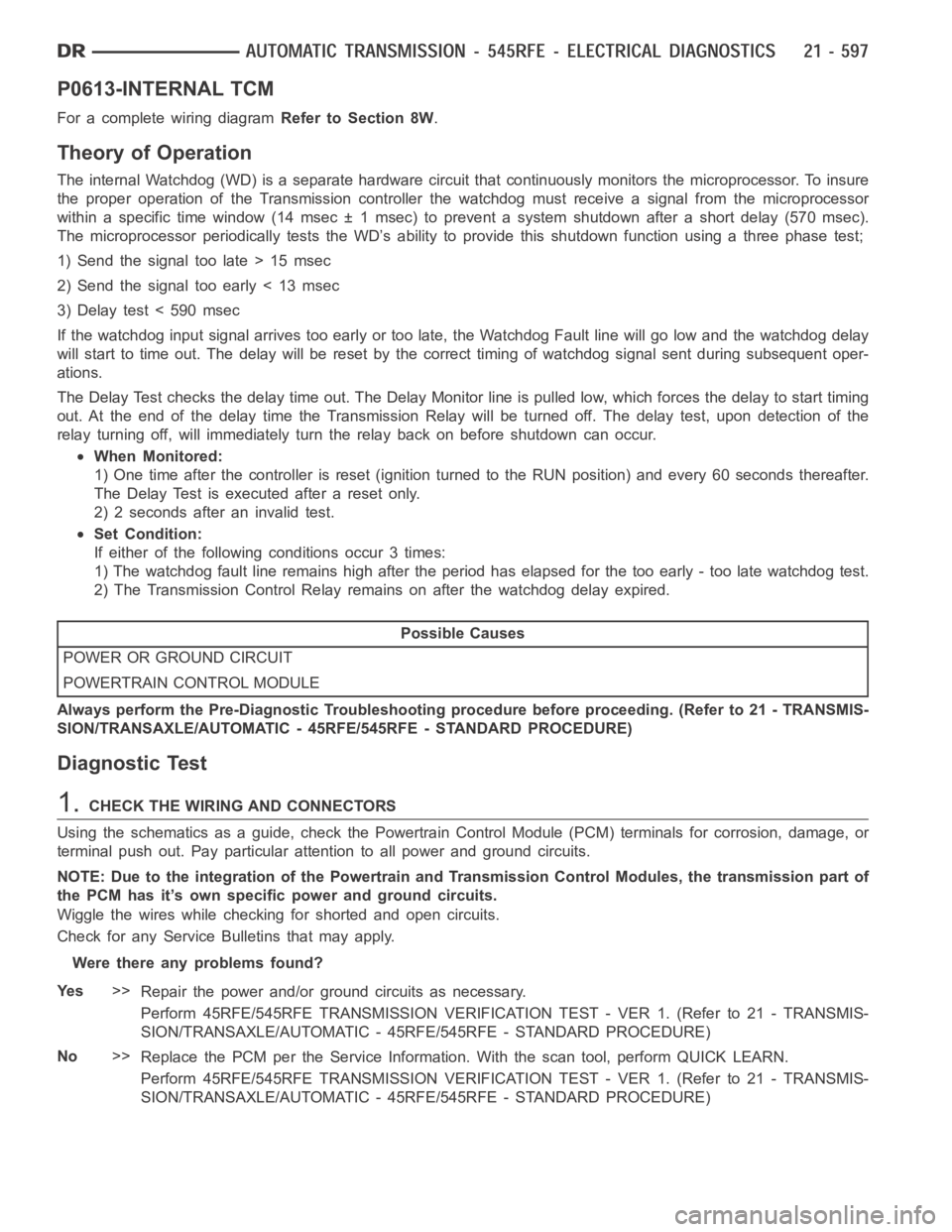Page 3118 of 5267

P0613-INTERNAL TCM
For a complete wiring diagramRefer to Section 8W.
Theory of Operation
The internal Watchdog (WD) is a separate hardware circuit that continuously monitors the microprocessor. To insure
the proper operation of the Transmission controller the watchdog must receive a signal from the microprocessor
within a specific time window (14 msec ± 1 msec) to prevent a system shutdownafter a short delay (570 msec).
The microprocessor periodically tests the WD’s ability to provide this shutdown function using a three phase test;
1) Send the signal too late > 15 msec
2) Send the signal too early < 13 msec
3) Delay test < 590 msec
If the watchdog input signal arrives too early or too late, the Watchdog Fault line will go low and the watchdog delay
will start to time out. The delay will be reset by the correct timing of watchdog signal sent during subsequent oper-
ations.
The Delay Test checks the delay time out. The Delay Monitor line is pulled low, which forces the delay to start timing
out. At the end of the delay time the Transmission Relay will be turned off. The delay test, upon detection of the
relay turning off, will immediately turn the relay back on before shutdowncan occur.
When Monitored:
1) One time after the controller is reset (ignition turned to the RUN position) and every 60 seconds thereafter.
The Delay Test is executed after a reset only.
2) 2 seconds after an invalid test.
Set Condition:
If either of the following conditions occur 3 times:
1) The watchdog fault line remains high after the period has elapsed for thetoo early - too late watchdog test.
2) The Transmission Control Relay remains on after the watchdog delay expired.
Possible Causes
POWERORGROUNDCIRCUIT
POWERTRAIN CONTROL MODULE
Always perform the Pre-Diagnostic Troubleshooting procedure before proceeding. (Refer to 21 - TRANSMIS-
SION/TRANSAXLE/AUTOMATIC - 45RFE/545RFE - STANDARD PROCEDURE)
Diagnostic Test
1.CHECK THE WIRING AND CONNECTORS
Using the schematics as a guide, check the Powertrain Control Module (PCM)terminals for corrosion, damage, or
terminal push out. Pay particular attention to all power and ground circuits.
NOTE: Due to the integration of the Powertrain and Transmission Control Modules, the transmission part of
the PCM has it’s own specific power and ground circuits.
Wiggle the wires while checking for shorted and open circuits.
Check for any Service Bulletins that may apply.
Were there any problems found?
Ye s>>
Repair the power and/or ground circuits as necessary.
Perform 45RFE/545RFE TRANSMISSION VERIFICATION TEST - VER 1. (Refer to 21- TRANSMIS-
SION/TRANSAXLE/AUTOMATIC - 45RFE/545RFE - STANDARD PROCEDURE)
No>>
Replace the PCM per the Service Information. With the scan tool, perform QUICK LEARN.
Perform 45RFE/545RFE TRANSMISSION VERIFICATION TEST - VER 1. (Refer to 21- TRANSMIS-
SION/TRANSAXLE/AUTOMATIC - 45RFE/545RFE - STANDARD PROCEDURE)
Page 3119 of 5267
P0706-TRANSMISSION RANGE SENSOR RATIONALITY
For a complete wiring diagramRefer to Section 8W.
Page 3123 of 5267
P0711-TRANSMISSION TEMPERATURE SENSOR PERFORMANCE
For a complete wiring diagramRefer to Section 8W.
Page 3126 of 5267
P0712-TRANSMISSION TEMPERATURE SENSOR LOW
For a complete wiring diagramRefer to Section 8W.
Page 3129 of 5267
P0713-TRANSMISSION TEMPERATURE SENSOR HIGH
For a complete wiring diagramRefer to Section 8W.
Page 3132 of 5267
P0714-TRANSMISSION TEMPERATURE SENSOR INTERMITTENT
For a complete wiring diagramRefer to Section 8W.
Page 3135 of 5267
P0715-INPUT SPEED SENSOR 1 CIRCUIT
For a complete wiring diagramRefer to Section 8W.
Page 3141 of 5267
P0720-OUTPUT SPEED SENSOR CIRCUIT
For a complete wiring diagramRefer to Section 8W.